Exploring the Effects of Public Relations on Popular Culture & Society
VerifiedAdded on 2023/06/04
|9
|2186
|326
Essay
AI Summary
This essay provides a comprehensive overview of public relations, examining its effects on popular culture, globalization, and its historical development. It begins by discussing the relationship between popular culture and public relations, highlighting how media, particularly television and films, shape public perception of PR professionals. The essay then explores the impact of globalization on public relations, emphasizing the need for practitioners to understand cultural, political, economic, and media systems in a global context. Finally, it delves into the history of public relations, tracing its origins to ancient Greece and highlighting the contributions of key figures like Ivy Lee and Edward Bernays, who shaped the industry into its modern form. The essay concludes by emphasizing the importance of understanding the history of public relations for emerging professionals. Desklib offers similar essays and study tools for students.
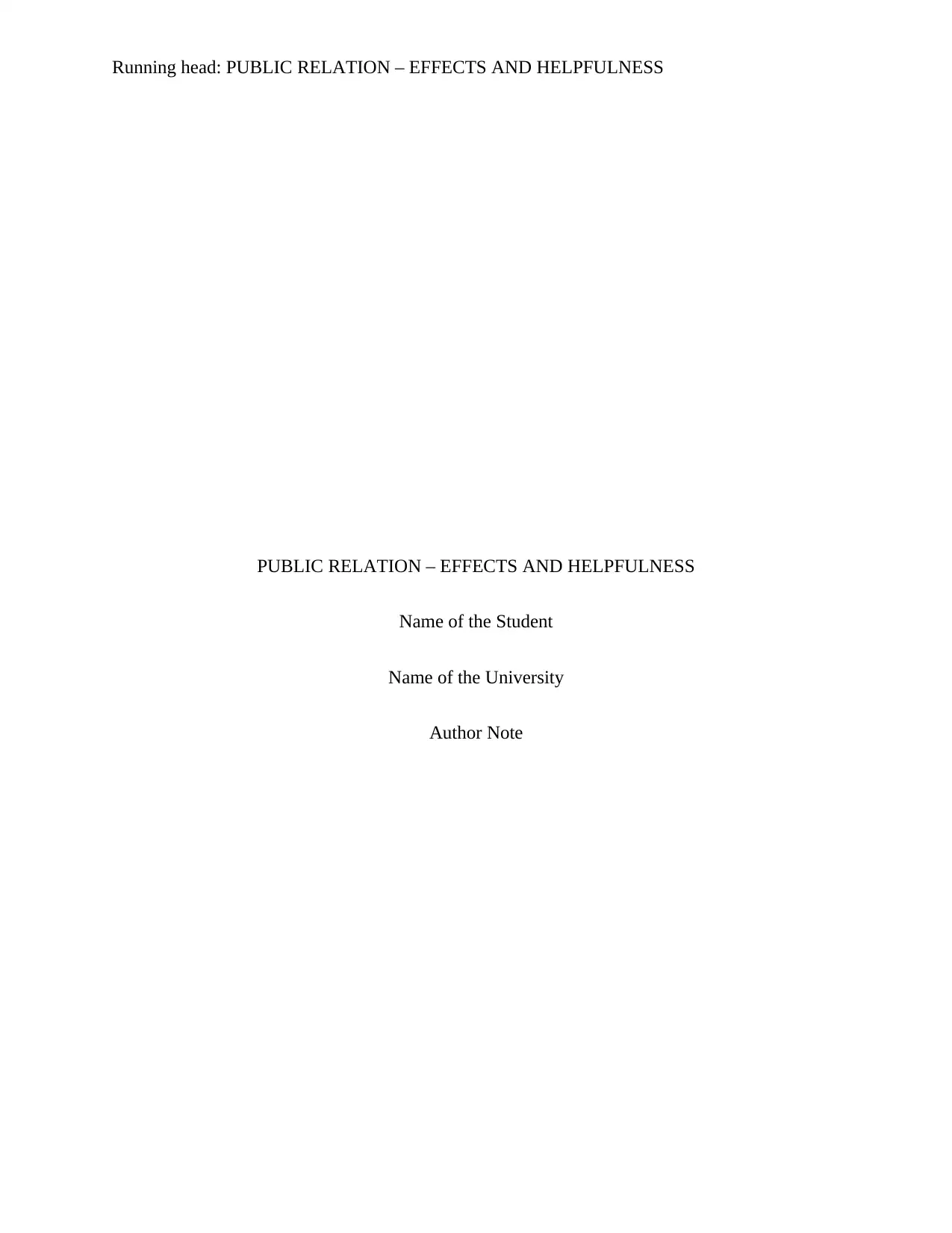
Running head: PUBLIC RELATION – EFFECTS AND HELPFULNESS
PUBLIC RELATION – EFFECTS AND HELPFULNESS
Name of the Student
Name of the University
Author Note
PUBLIC RELATION – EFFECTS AND HELPFULNESS
Name of the Student
Name of the University
Author Note
Paraphrase This Document
Need a fresh take? Get an instant paraphrase of this document with our AI Paraphraser

1PUBLIC RELATION – EFFECTS AND HELPFULNESS
Topic 4: Popular culture and public relation
The term popular culture is generally recognized as the vernacular or culture of people
that is predominant in a society, at a particular point of time. Popular culture includes various
aspects of social life involving general public. It is also informed to us by the mass media. There
are various examples of popular culture comes from wide ranges of genres, that includes popular
music, cyber culture, entertainment, leisure even advertising and television (Wimmer, Roger and
Joseph 2013). Television is the most arguable of widely consumed forms of popular culture, and
it also represents a strong staying power. The reason behind this staying power is that people
spend hours after hours watching television every day. It has become such a prevalent aspect that
it made imagining life without television difficult (Hutton, James and Mak 2014).
Public relation being a significant industry, its work encompasses a wide range of
strategies related to communication and certain tactics like public affairs, media relations and
lobbying. It has a close relation with advertising, media industries and marketing activities
promoting products, services, brands in order to make changes in the behavior and attitude of the
audiences (Davis 2013). As in case of advertising, a combination of images and words is used
are combined to portray a particular message, although the written and spoken word (in various
forms like press releases, interviews and communication that is web based), similarly when
television and movies elements of popular culture are concerned public relation plays a huge
role.
Joe Saltzman, a professor of University of Southern California performed the largest
research on near about 327 films in English language and TV programs from 1901 to 2011
(Saltzman 2018). The negative image of PR professionals has largely changed to much more
varied images. Up to 2011, it was observed that women PR practitioners were far better in
Topic 4: Popular culture and public relation
The term popular culture is generally recognized as the vernacular or culture of people
that is predominant in a society, at a particular point of time. Popular culture includes various
aspects of social life involving general public. It is also informed to us by the mass media. There
are various examples of popular culture comes from wide ranges of genres, that includes popular
music, cyber culture, entertainment, leisure even advertising and television (Wimmer, Roger and
Joseph 2013). Television is the most arguable of widely consumed forms of popular culture, and
it also represents a strong staying power. The reason behind this staying power is that people
spend hours after hours watching television every day. It has become such a prevalent aspect that
it made imagining life without television difficult (Hutton, James and Mak 2014).
Public relation being a significant industry, its work encompasses a wide range of
strategies related to communication and certain tactics like public affairs, media relations and
lobbying. It has a close relation with advertising, media industries and marketing activities
promoting products, services, brands in order to make changes in the behavior and attitude of the
audiences (Davis 2013). As in case of advertising, a combination of images and words is used
are combined to portray a particular message, although the written and spoken word (in various
forms like press releases, interviews and communication that is web based), similarly when
television and movies elements of popular culture are concerned public relation plays a huge
role.
Joe Saltzman, a professor of University of Southern California performed the largest
research on near about 327 films in English language and TV programs from 1901 to 2011
(Saltzman 2018). The negative image of PR professionals has largely changed to much more
varied images. Up to 2011, it was observed that women PR practitioners were far better in

2PUBLIC RELATION – EFFECTS AND HELPFULNESS
television performance, the count being 60 women characters opposed to 68 male characters
which increased compared to 189 male characters against 44 women characters during the period
of 1920-1990 (Saltzman 2018). ) Press secretaries, political aids, and police information officers
are found to be the diversified PR professionals in movies and television. However PR
practitioners may play the role of a hero who raises the voices against any unethical practices and
will quit the job even but will refrain from doing anything immoral. They often get portrayed as
anguished people who only performs jobs with high standards. One important part of this image
is that it has a positive image created in the mind of public when portrayed in televisions and
films. Negative images may include men and women preferring to do anything for their clients
and specially PR women using their charms to win over clients for getting ahead in profession to
villains who lie or cheat and even do murder to save own reputations. Thus, Public relation may
affect society by portraying negative images of PR professionals through popular culture
elements like television and media and help the PR professionals in gaining fame by positive
image of PR professionals.
Topic 2: Public Relation affecting Globalization
Globalization in past was defined as a strategy that has the capability of lifting all boats
both in poor and rich countries that is raising the standard to a same level (Collins 2018). To
some globalization has positive effects such as free trade helps in reducing various barriers like
tax which help in economic growth, creates opportunities for jobs. They argue that globalization
has potential in making this world, a better place to live in. On the other side some people have
views like globalization have made richer more rich and the poorer to remain poor. Even they are
of the opinion that, multinational corporations have been accused of unfair working conditions
television performance, the count being 60 women characters opposed to 68 male characters
which increased compared to 189 male characters against 44 women characters during the period
of 1920-1990 (Saltzman 2018). ) Press secretaries, political aids, and police information officers
are found to be the diversified PR professionals in movies and television. However PR
practitioners may play the role of a hero who raises the voices against any unethical practices and
will quit the job even but will refrain from doing anything immoral. They often get portrayed as
anguished people who only performs jobs with high standards. One important part of this image
is that it has a positive image created in the mind of public when portrayed in televisions and
films. Negative images may include men and women preferring to do anything for their clients
and specially PR women using their charms to win over clients for getting ahead in profession to
villains who lie or cheat and even do murder to save own reputations. Thus, Public relation may
affect society by portraying negative images of PR professionals through popular culture
elements like television and media and help the PR professionals in gaining fame by positive
image of PR professionals.
Topic 2: Public Relation affecting Globalization
Globalization in past was defined as a strategy that has the capability of lifting all boats
both in poor and rich countries that is raising the standard to a same level (Collins 2018). To
some globalization has positive effects such as free trade helps in reducing various barriers like
tax which help in economic growth, creates opportunities for jobs. They argue that globalization
has potential in making this world, a better place to live in. On the other side some people have
views like globalization have made richer more rich and the poorer to remain poor. Even they are
of the opinion that, multinational corporations have been accused of unfair working conditions
⊘ This is a preview!⊘
Do you want full access?
Subscribe today to unlock all pages.

Trusted by 1+ million students worldwide

3PUBLIC RELATION – EFFECTS AND HELPFULNESS
like slave labor wages and also reported of little concern for environment & ecological damage
(Burlacu et al. 2018).
However globalization has also affected public relations. The term global public relation
can be used as it has an intersection of public relation and globalization. This global public
relation in a theoretical framework is proposed to have five environmental variables like, culture,
activism, political system, media system and lastly the economic system (Sriramesh and
Krishnamurthy 2008). In political system variable it is expected that a global public relation
practitioner needs to have the ability to contextualize the variable political environments such as
monarchy, theocracy and communitarism. In economic system, the economic development of
any country has a crucial role to play in public relation. In this era of globalization, the
concentration is on shift of economic power to a new one from the traditional players or power.
These changes resulted in public relations to take newer challenges in newer markets. The public
relations infrastructure has improved in many regions that is out of the traditional public relations
power centers boundary in USA and few countries of Western Europe (Sriramesh and
Krishnamurthy 2008).
Public relation itself is portrayed as a culture where public relations practitioners can be
identified by one as having an own professional culture that is different from other professionals
who are communication oriented in journalism advertising and others. Public relations
scholarship needs to integrate culture into the knowledge body. Naturally it is lagging behind and
is preparing the field of challenges for globalization (Sriramesh and Krishnamurthy 2008). In
media systems variable exists an assumption that public relations is only related to maintain
relationships with the journalists on behalf of organization – termed as media relations. This
assumption comes from the fact that mass media is frequently used by public relations
like slave labor wages and also reported of little concern for environment & ecological damage
(Burlacu et al. 2018).
However globalization has also affected public relations. The term global public relation
can be used as it has an intersection of public relation and globalization. This global public
relation in a theoretical framework is proposed to have five environmental variables like, culture,
activism, political system, media system and lastly the economic system (Sriramesh and
Krishnamurthy 2008). In political system variable it is expected that a global public relation
practitioner needs to have the ability to contextualize the variable political environments such as
monarchy, theocracy and communitarism. In economic system, the economic development of
any country has a crucial role to play in public relation. In this era of globalization, the
concentration is on shift of economic power to a new one from the traditional players or power.
These changes resulted in public relations to take newer challenges in newer markets. The public
relations infrastructure has improved in many regions that is out of the traditional public relations
power centers boundary in USA and few countries of Western Europe (Sriramesh and
Krishnamurthy 2008).
Public relation itself is portrayed as a culture where public relations practitioners can be
identified by one as having an own professional culture that is different from other professionals
who are communication oriented in journalism advertising and others. Public relations
scholarship needs to integrate culture into the knowledge body. Naturally it is lagging behind and
is preparing the field of challenges for globalization (Sriramesh and Krishnamurthy 2008). In
media systems variable exists an assumption that public relations is only related to maintain
relationships with the journalists on behalf of organization – termed as media relations. This
assumption comes from the fact that mass media is frequently used by public relations
Paraphrase This Document
Need a fresh take? Get an instant paraphrase of this document with our AI Paraphraser
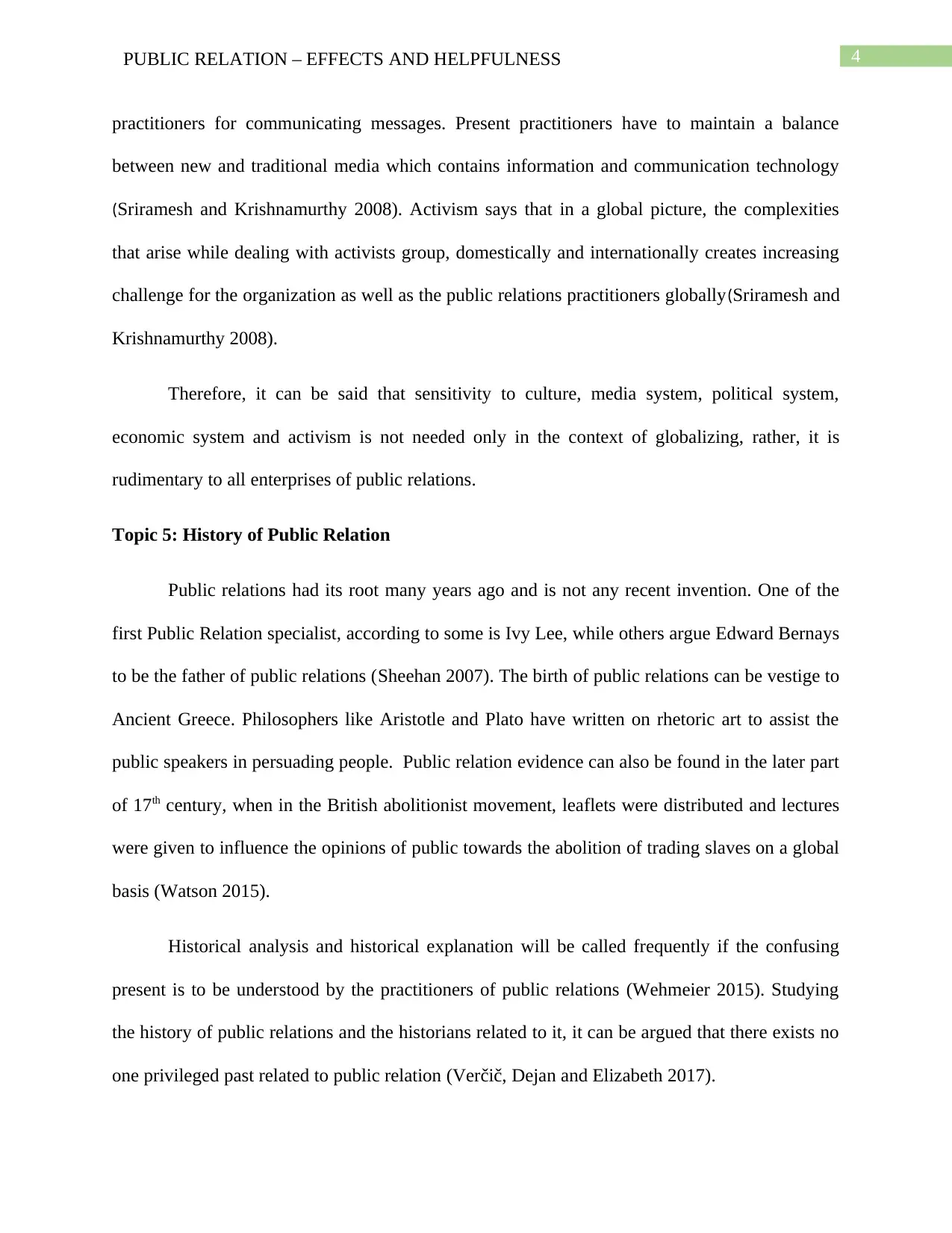
4PUBLIC RELATION – EFFECTS AND HELPFULNESS
practitioners for communicating messages. Present practitioners have to maintain a balance
between new and traditional media which contains information and communication technology
(Sriramesh and Krishnamurthy 2008). Activism says that in a global picture, the complexities
that arise while dealing with activists group, domestically and internationally creates increasing
challenge for the organization as well as the public relations practitioners globally(Sriramesh and
Krishnamurthy 2008).
Therefore, it can be said that sensitivity to culture, media system, political system,
economic system and activism is not needed only in the context of globalizing, rather, it is
rudimentary to all enterprises of public relations.
Topic 5: History of Public Relation
Public relations had its root many years ago and is not any recent invention. One of the
first Public Relation specialist, according to some is Ivy Lee, while others argue Edward Bernays
to be the father of public relations (Sheehan 2007). The birth of public relations can be vestige to
Ancient Greece. Philosophers like Aristotle and Plato have written on rhetoric art to assist the
public speakers in persuading people. Public relation evidence can also be found in the later part
of 17th century, when in the British abolitionist movement, leaflets were distributed and lectures
were given to influence the opinions of public towards the abolition of trading slaves on a global
basis (Watson 2015).
Historical analysis and historical explanation will be called frequently if the confusing
present is to be understood by the practitioners of public relations (Wehmeier 2015). Studying
the history of public relations and the historians related to it, it can be argued that there exists no
one privileged past related to public relation (Verčič, Dejan and Elizabeth 2017).
practitioners for communicating messages. Present practitioners have to maintain a balance
between new and traditional media which contains information and communication technology
(Sriramesh and Krishnamurthy 2008). Activism says that in a global picture, the complexities
that arise while dealing with activists group, domestically and internationally creates increasing
challenge for the organization as well as the public relations practitioners globally(Sriramesh and
Krishnamurthy 2008).
Therefore, it can be said that sensitivity to culture, media system, political system,
economic system and activism is not needed only in the context of globalizing, rather, it is
rudimentary to all enterprises of public relations.
Topic 5: History of Public Relation
Public relations had its root many years ago and is not any recent invention. One of the
first Public Relation specialist, according to some is Ivy Lee, while others argue Edward Bernays
to be the father of public relations (Sheehan 2007). The birth of public relations can be vestige to
Ancient Greece. Philosophers like Aristotle and Plato have written on rhetoric art to assist the
public speakers in persuading people. Public relation evidence can also be found in the later part
of 17th century, when in the British abolitionist movement, leaflets were distributed and lectures
were given to influence the opinions of public towards the abolition of trading slaves on a global
basis (Watson 2015).
Historical analysis and historical explanation will be called frequently if the confusing
present is to be understood by the practitioners of public relations (Wehmeier 2015). Studying
the history of public relations and the historians related to it, it can be argued that there exists no
one privileged past related to public relation (Verčič, Dejan and Elizabeth 2017).
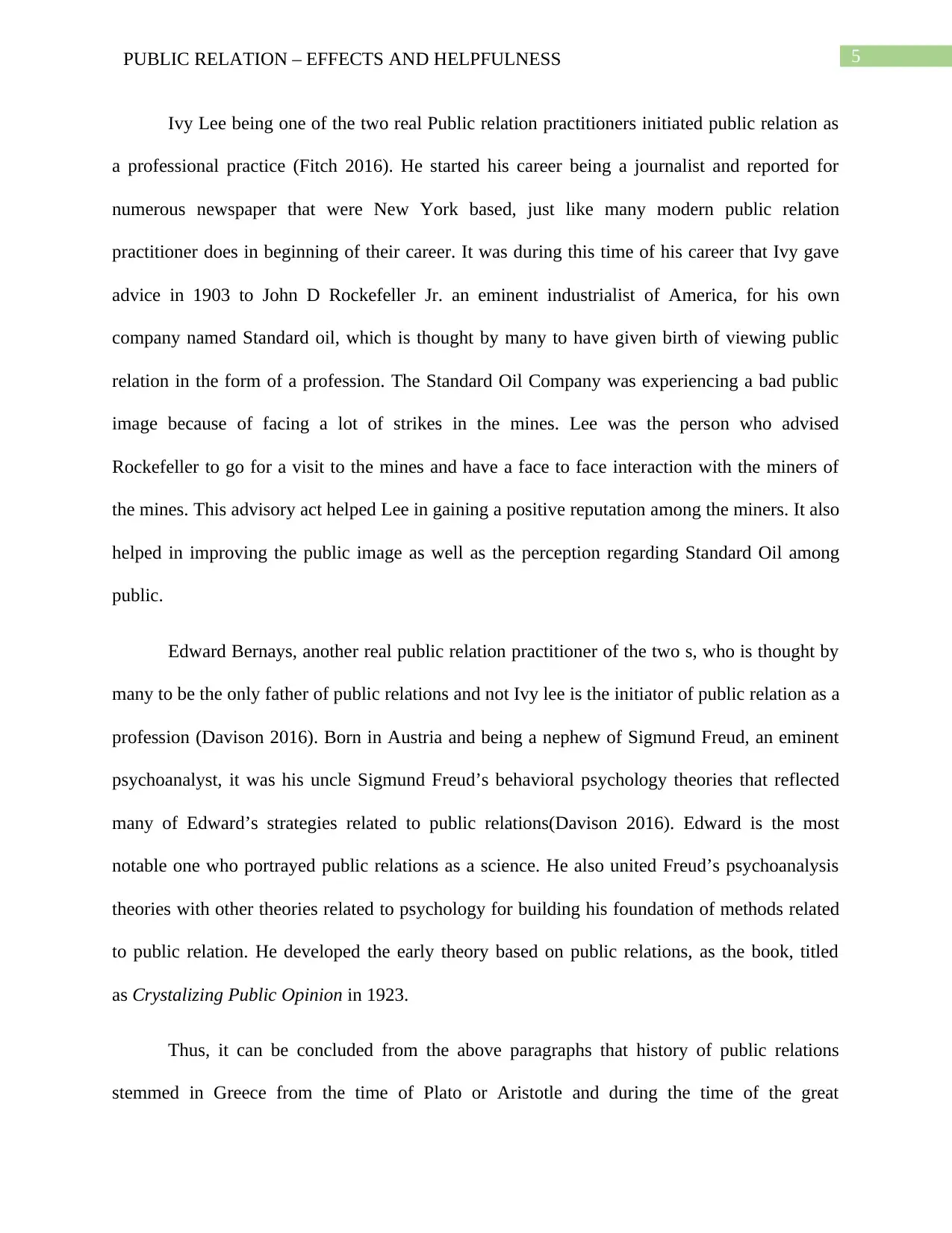
5PUBLIC RELATION – EFFECTS AND HELPFULNESS
Ivy Lee being one of the two real Public relation practitioners initiated public relation as
a professional practice (Fitch 2016). He started his career being a journalist and reported for
numerous newspaper that were New York based, just like many modern public relation
practitioner does in beginning of their career. It was during this time of his career that Ivy gave
advice in 1903 to John D Rockefeller Jr. an eminent industrialist of America, for his own
company named Standard oil, which is thought by many to have given birth of viewing public
relation in the form of a profession. The Standard Oil Company was experiencing a bad public
image because of facing a lot of strikes in the mines. Lee was the person who advised
Rockefeller to go for a visit to the mines and have a face to face interaction with the miners of
the mines. This advisory act helped Lee in gaining a positive reputation among the miners. It also
helped in improving the public image as well as the perception regarding Standard Oil among
public.
Edward Bernays, another real public relation practitioner of the two s, who is thought by
many to be the only father of public relations and not Ivy lee is the initiator of public relation as a
profession (Davison 2016). Born in Austria and being a nephew of Sigmund Freud, an eminent
psychoanalyst, it was his uncle Sigmund Freud’s behavioral psychology theories that reflected
many of Edward’s strategies related to public relations(Davison 2016). Edward is the most
notable one who portrayed public relations as a science. He also united Freud’s psychoanalysis
theories with other theories related to psychology for building his foundation of methods related
to public relation. He developed the early theory based on public relations, as the book, titled
as Crystalizing Public Opinion in 1923.
Thus, it can be concluded from the above paragraphs that history of public relations
stemmed in Greece from the time of Plato or Aristotle and during the time of the great
Ivy Lee being one of the two real Public relation practitioners initiated public relation as
a professional practice (Fitch 2016). He started his career being a journalist and reported for
numerous newspaper that were New York based, just like many modern public relation
practitioner does in beginning of their career. It was during this time of his career that Ivy gave
advice in 1903 to John D Rockefeller Jr. an eminent industrialist of America, for his own
company named Standard oil, which is thought by many to have given birth of viewing public
relation in the form of a profession. The Standard Oil Company was experiencing a bad public
image because of facing a lot of strikes in the mines. Lee was the person who advised
Rockefeller to go for a visit to the mines and have a face to face interaction with the miners of
the mines. This advisory act helped Lee in gaining a positive reputation among the miners. It also
helped in improving the public image as well as the perception regarding Standard Oil among
public.
Edward Bernays, another real public relation practitioner of the two s, who is thought by
many to be the only father of public relations and not Ivy lee is the initiator of public relation as a
profession (Davison 2016). Born in Austria and being a nephew of Sigmund Freud, an eminent
psychoanalyst, it was his uncle Sigmund Freud’s behavioral psychology theories that reflected
many of Edward’s strategies related to public relations(Davison 2016). Edward is the most
notable one who portrayed public relations as a science. He also united Freud’s psychoanalysis
theories with other theories related to psychology for building his foundation of methods related
to public relation. He developed the early theory based on public relations, as the book, titled
as Crystalizing Public Opinion in 1923.
Thus, it can be concluded from the above paragraphs that history of public relations
stemmed in Greece from the time of Plato or Aristotle and during the time of the great
⊘ This is a preview!⊘
Do you want full access?
Subscribe today to unlock all pages.

Trusted by 1+ million students worldwide
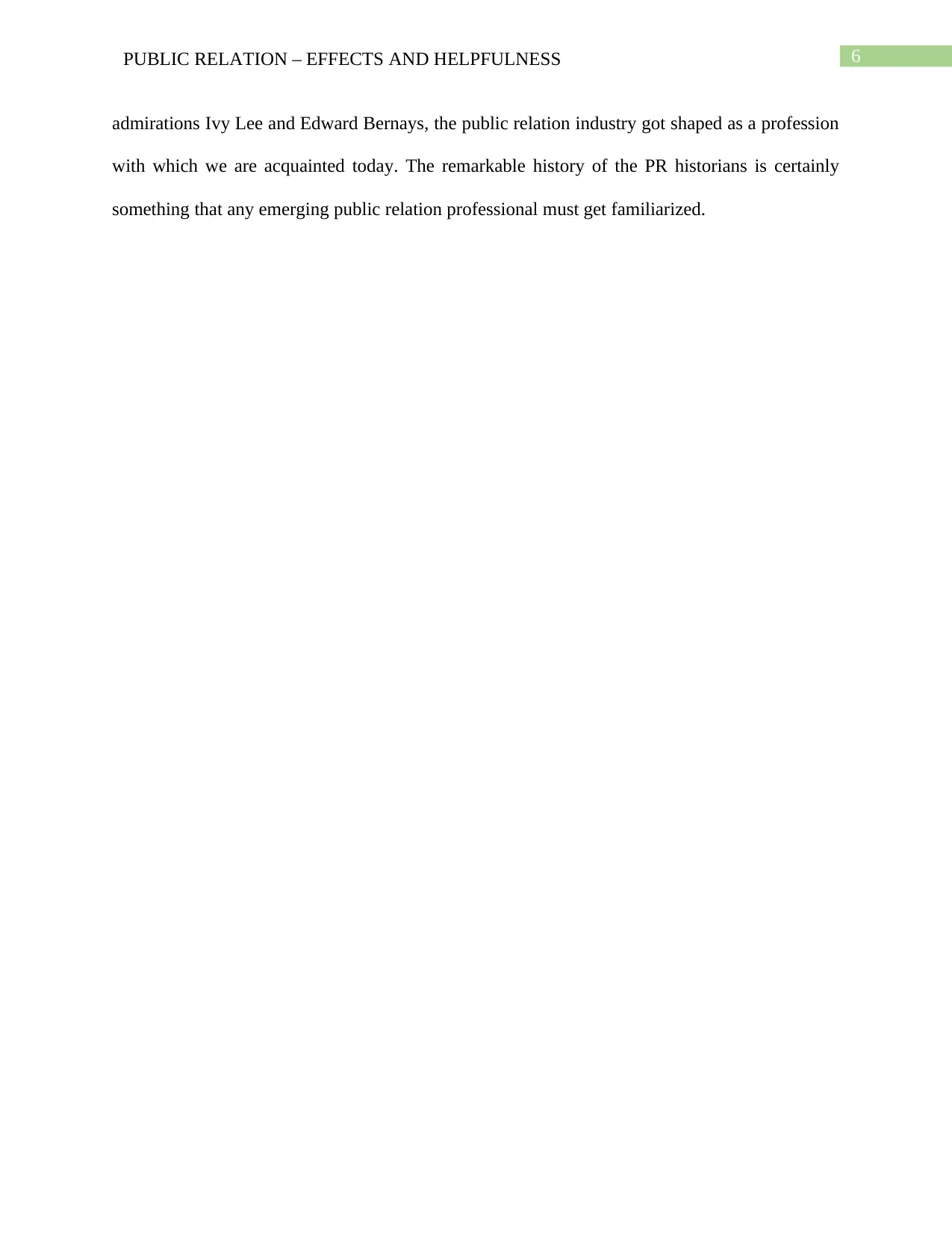
6PUBLIC RELATION – EFFECTS AND HELPFULNESS
admirations Ivy Lee and Edward Bernays, the public relation industry got shaped as a profession
with which we are acquainted today. The remarkable history of the PR historians is certainly
something that any emerging public relation professional must get familiarized.
admirations Ivy Lee and Edward Bernays, the public relation industry got shaped as a profession
with which we are acquainted today. The remarkable history of the PR historians is certainly
something that any emerging public relation professional must get familiarized.
Paraphrase This Document
Need a fresh take? Get an instant paraphrase of this document with our AI Paraphraser
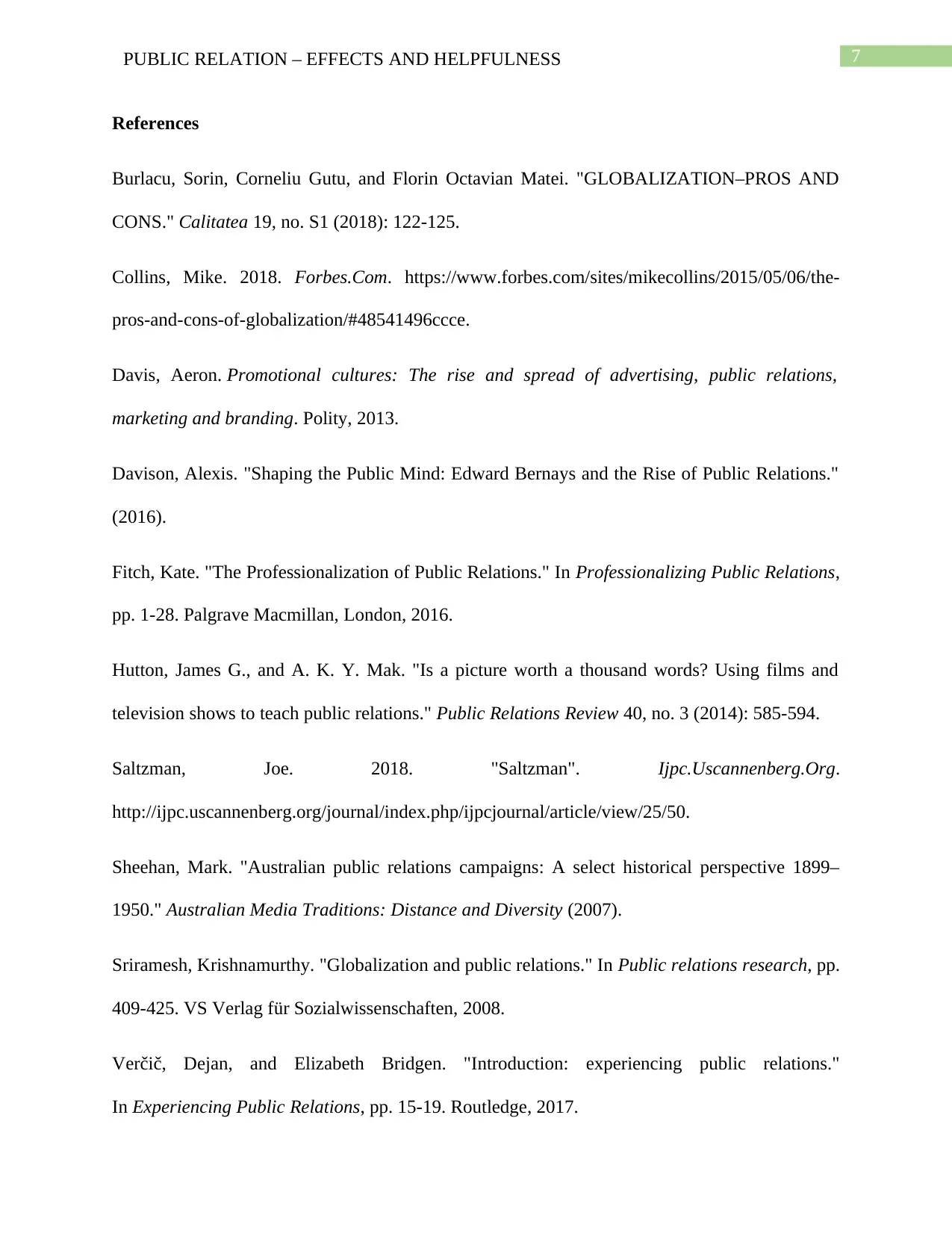
7PUBLIC RELATION – EFFECTS AND HELPFULNESS
References
Burlacu, Sorin, Corneliu Gutu, and Florin Octavian Matei. "GLOBALIZATION–PROS AND
CONS." Calitatea 19, no. S1 (2018): 122-125.
Collins, Mike. 2018. Forbes.Com. https://www.forbes.com/sites/mikecollins/2015/05/06/the-
pros-and-cons-of-globalization/#48541496ccce.
Davis, Aeron. Promotional cultures: The rise and spread of advertising, public relations,
marketing and branding. Polity, 2013.
Davison, Alexis. "Shaping the Public Mind: Edward Bernays and the Rise of Public Relations."
(2016).
Fitch, Kate. "The Professionalization of Public Relations." In Professionalizing Public Relations,
pp. 1-28. Palgrave Macmillan, London, 2016.
Hutton, James G., and A. K. Y. Mak. "Is a picture worth a thousand words? Using films and
television shows to teach public relations." Public Relations Review 40, no. 3 (2014): 585-594.
Saltzman, Joe. 2018. "Saltzman". Ijpc.Uscannenberg.Org.
http://ijpc.uscannenberg.org/journal/index.php/ijpcjournal/article/view/25/50.
Sheehan, Mark. "Australian public relations campaigns: A select historical perspective 1899–
1950." Australian Media Traditions: Distance and Diversity (2007).
Sriramesh, Krishnamurthy. "Globalization and public relations." In Public relations research, pp.
409-425. VS Verlag für Sozialwissenschaften, 2008.
Verčič, Dejan, and Elizabeth Bridgen. "Introduction: experiencing public relations."
In Experiencing Public Relations, pp. 15-19. Routledge, 2017.
References
Burlacu, Sorin, Corneliu Gutu, and Florin Octavian Matei. "GLOBALIZATION–PROS AND
CONS." Calitatea 19, no. S1 (2018): 122-125.
Collins, Mike. 2018. Forbes.Com. https://www.forbes.com/sites/mikecollins/2015/05/06/the-
pros-and-cons-of-globalization/#48541496ccce.
Davis, Aeron. Promotional cultures: The rise and spread of advertising, public relations,
marketing and branding. Polity, 2013.
Davison, Alexis. "Shaping the Public Mind: Edward Bernays and the Rise of Public Relations."
(2016).
Fitch, Kate. "The Professionalization of Public Relations." In Professionalizing Public Relations,
pp. 1-28. Palgrave Macmillan, London, 2016.
Hutton, James G., and A. K. Y. Mak. "Is a picture worth a thousand words? Using films and
television shows to teach public relations." Public Relations Review 40, no. 3 (2014): 585-594.
Saltzman, Joe. 2018. "Saltzman". Ijpc.Uscannenberg.Org.
http://ijpc.uscannenberg.org/journal/index.php/ijpcjournal/article/view/25/50.
Sheehan, Mark. "Australian public relations campaigns: A select historical perspective 1899–
1950." Australian Media Traditions: Distance and Diversity (2007).
Sriramesh, Krishnamurthy. "Globalization and public relations." In Public relations research, pp.
409-425. VS Verlag für Sozialwissenschaften, 2008.
Verčič, Dejan, and Elizabeth Bridgen. "Introduction: experiencing public relations."
In Experiencing Public Relations, pp. 15-19. Routledge, 2017.
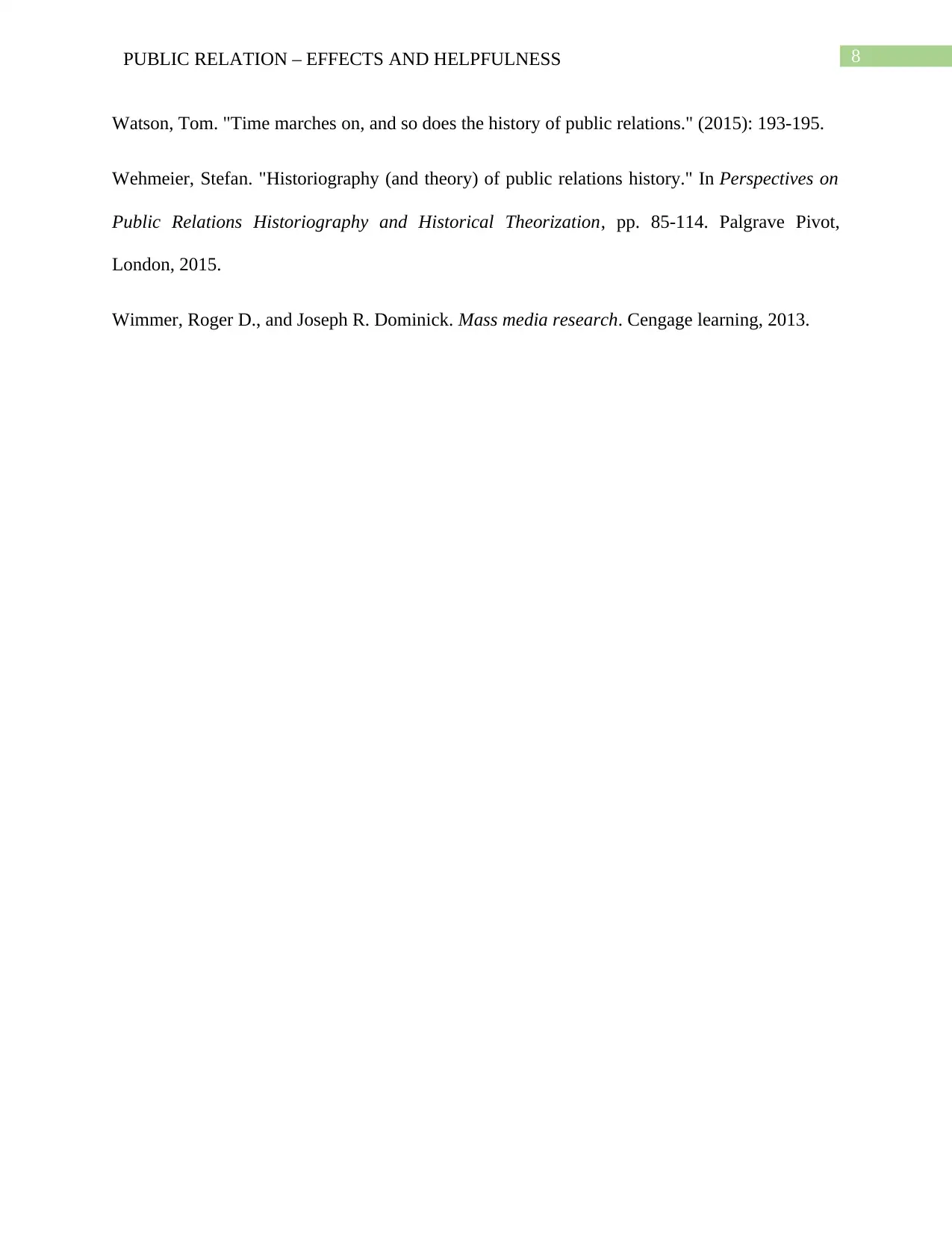
8PUBLIC RELATION – EFFECTS AND HELPFULNESS
Watson, Tom. "Time marches on, and so does the history of public relations." (2015): 193-195.
Wehmeier, Stefan. "Historiography (and theory) of public relations history." In Perspectives on
Public Relations Historiography and Historical Theorization, pp. 85-114. Palgrave Pivot,
London, 2015.
Wimmer, Roger D., and Joseph R. Dominick. Mass media research. Cengage learning, 2013.
Watson, Tom. "Time marches on, and so does the history of public relations." (2015): 193-195.
Wehmeier, Stefan. "Historiography (and theory) of public relations history." In Perspectives on
Public Relations Historiography and Historical Theorization, pp. 85-114. Palgrave Pivot,
London, 2015.
Wimmer, Roger D., and Joseph R. Dominick. Mass media research. Cengage learning, 2013.
⊘ This is a preview!⊘
Do you want full access?
Subscribe today to unlock all pages.

Trusted by 1+ million students worldwide
1 out of 9
Your All-in-One AI-Powered Toolkit for Academic Success.
+13062052269
info@desklib.com
Available 24*7 on WhatsApp / Email
![[object Object]](/_next/static/media/star-bottom.7253800d.svg)
Unlock your academic potential
Copyright © 2020–2025 A2Z Services. All Rights Reserved. Developed and managed by ZUCOL.
